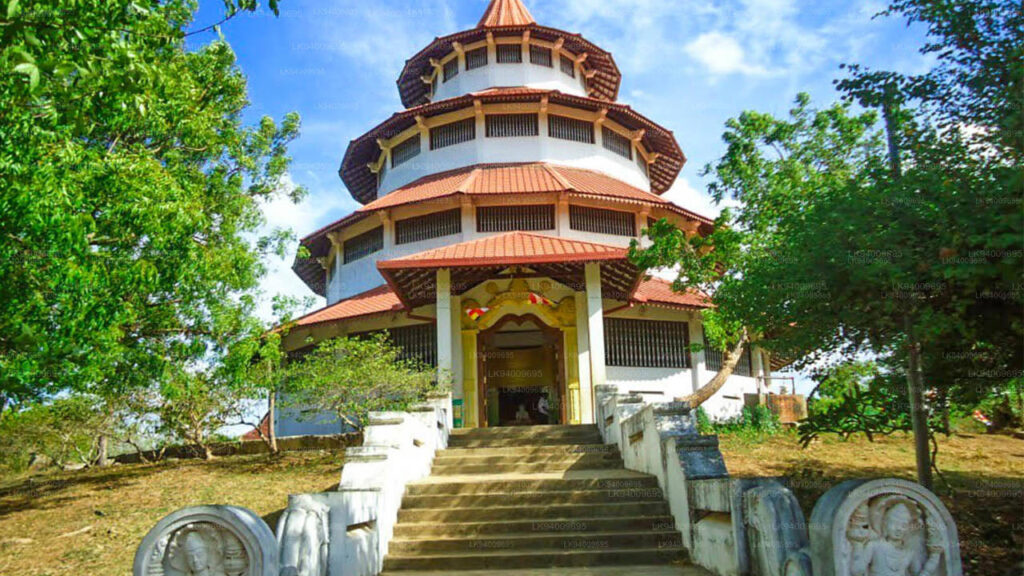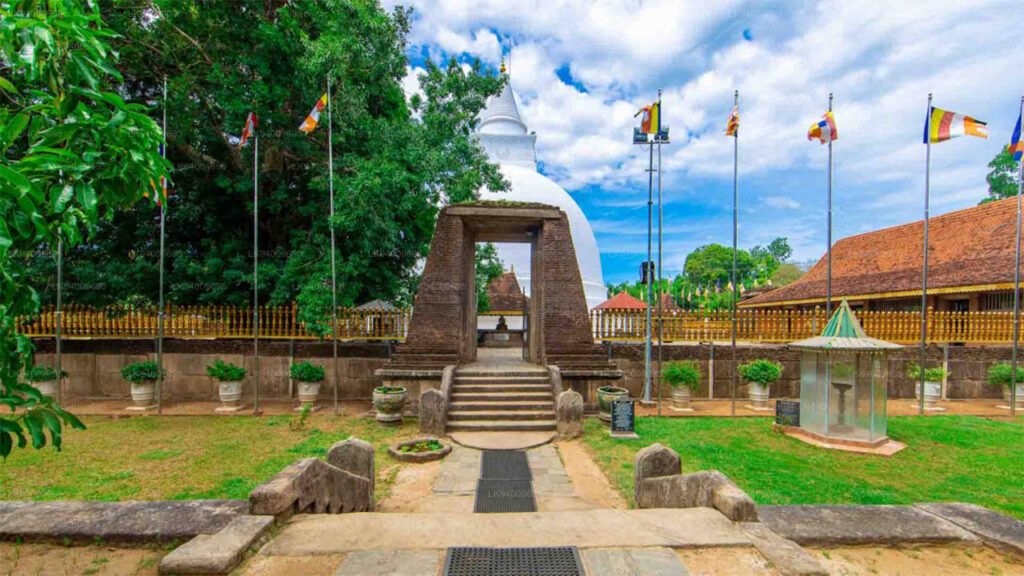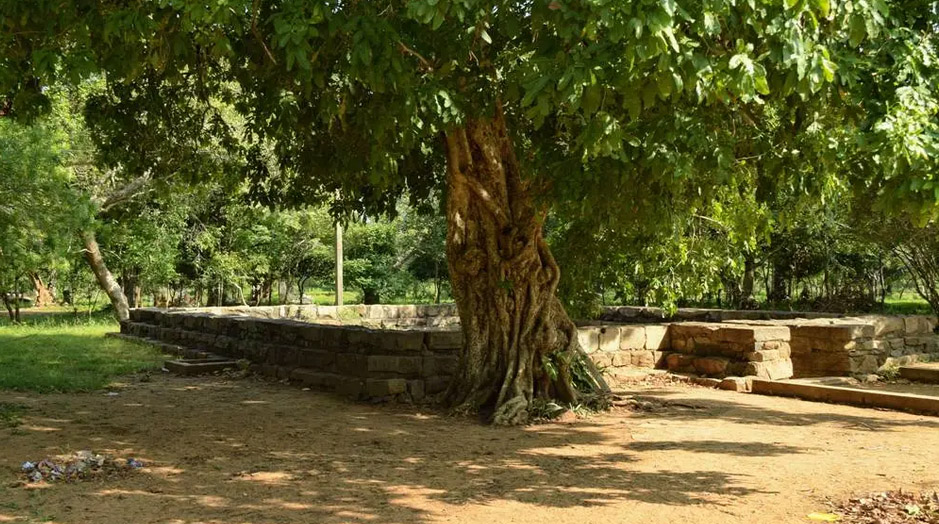The Historical Significance of Seruwila Mangala Raja Maha Vihara
The Seruwila Mangala Raja Maha Vihara is one of the 16 sacred Buddhist sites in Sri Lanka, believed to have been visited by Lord Buddha during his three visits to the island. According to ancient chronicles, the temple was built during the reign of King Kavantissa (2nd century BCE) to enshrine the sacred Lalata Dathun Wahanse (forehead bone relic) of Lord Buddha. This relic was brought to Sri Lanka from India, making the temple a significant pilgrimage site for Buddhists.
The temple’s name, Seruwila, is derived from the Sinhalese words “Seru” (a type of rice) and “Wila” (a paddy field), reflecting the agricultural abundance of the area. Over the centuries, the temple has undergone several renovations, yet it retains its ancient charm and spiritual aura.

Architectural Marvels and Sacred Relics
The Seruwila Mangala Raja Maha Vihara is a masterpiece of ancient Sri Lankan architecture. The temple complex features:
The Stupa (Dagoba): The main stupa, believed to house the sacred forehead bone relic, is an impressive structure that dominates the temple grounds. Its whitewashed dome and golden pinnacle shimmer under the tropical sun, creating a serene and awe-inspiring atmosphere.
The Image House: The temple’s image house is adorned with intricate murals and statues depicting scenes from the life of Lord Buddha. The craftsmanship reflects the artistic brilliance of ancient Sri Lankan artisans.
The Bodhi Tree: A sacred Bodhi tree, believed to be a sapling from the original tree under which Lord Buddha attained enlightenment, is venerated by devotees.
Ancient Inscriptions: The temple premises feature ancient stone inscriptions that provide insights into the history and cultural significance of the site.

History of Seruwila Mangala Raja Maha Vihara

It’s the only place in Sri Lanka where relics of all 4 past Buddhas of our aeon are venerated
After a few hundred years, the whole site had been forgotten by time and it was only during 1922 that it was rediscovered by Ven. Dambagasare Sumedhankara Thero and was subsequently restored. The conservation project concluded in 1931 and the whole region – a plot of 83 acres was designated as an archaeological reserve in 1962. During the conservation, the archaeological department of Sri Lanka unearthed numerous relics and artifacts at the site and they have been placed at many museums around the country.

Rediscovery and Restoration of Seruwila Mangala Raja Maha Vihara
The Spiritual Experience
Visiting the Seruwila Mangala Raja Maha Vihara is not just a journey through history but also a deeply spiritual experience. The tranquil surroundings, the gentle chants of monks, and the scent of incense create an atmosphere of peace and introspection. Devotees often meditate or offer prayers at the stupa, seeking blessings and inner peace.
The temple is particularly vibrant during Poson Poya (June) and Vesak Poya (May), when thousands of pilgrims flock to the site to participate in religious ceremonies and rituals.

How to get to Seruwila Mangala Raja Maha Vihara
From Trincomalee: Hire a tuk-tuk or take a bus to Seruwila. The journey takes about 1-1.5 hours, depending on road conditions.
From Colombo: Drive to Trincomalee via the A6 highway (approximately 6-7 hours) and then proceed to Seruwila.
Public Transport: Regular buses operate from Trincomalee to Seruwila, making it an affordable option for budget travelers.
Nearby Attractions
While visiting Seruwila, travelers can explore other fascinating sites in Trincomalee, including:
- Koneswaram Temple: A stunning Hindu temple with breathtaking ocean views.
- Nilaveli Beach: A pristine beach offering relaxation and water sports.
- Pigeon Island National Park: A paradise for snorkeling and marine life enthusiasts.
- Hot Water Wells (Kanniya Hot Springs): Natural thermal springs with historical significance.
Tips for Visitors
- Dress Modestly: As a place of worship, visitors are expected to dress modestly. Cover your shoulders and knees, and remove footwear before entering sacred areas.
- Respect Local Customs: Be mindful of local customs and rituals. Avoid loud conversations and maintain a respectful demeanor.
- Stay Hydrated: Carry a water bottle, especially if visiting during the warmer months.
- Guided Tours: Consider hiring a local guide to gain deeper insights into the temple’s history and significance.
- Combine with Other Attractions: Trincomalee is home to stunning beaches, such as Nilaveli and Uppuveli, as well as the iconic Koneswaram Temple. Plan a day trip to explore these nearby attractions.
Best Time to Visit
The best time to visit the Seruwila Mangala Raja Maha Vihara is during the dry season (May to September), when the weather is pleasant and ideal for exploring the temple grounds. Early mornings or late afternoons are recommended to avoid the midday heat.
Location
Videos
Final Thoughts
Seruwila Mangala Raja Maha Vihara is not just a religious site but a historical and cultural treasure in Sri Lanka. Whether you seek spiritual enlightenment, historical exploration, or a tranquil retreat, this temple offers a profound experience that stays with visitors long after they leave. Plan your journey to Seruwila and immerse yourself in the rich heritage and spiritual essence of Trincomalee’s sacred landscape.
Other attractions around Trincomalee






